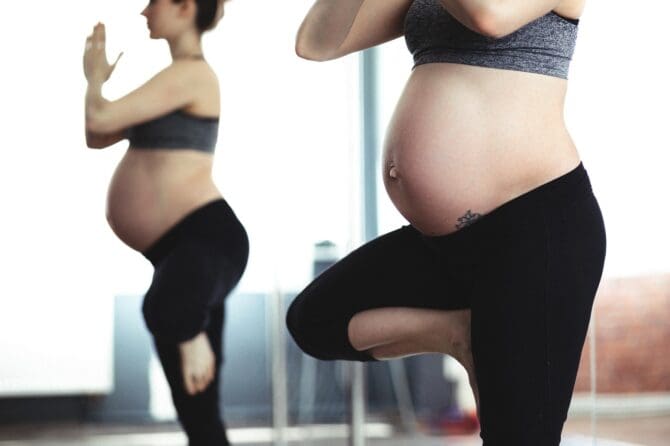Exploring the Benefits of Yoga for Fertility
An in-depth look at how practicing yoga can positively impact fertility and increase the chances of conception.
Yoga is not only a physical exercise but also a holistic practice that can have a profound impact on various aspects of our well-being. When it comes to fertility, yoga has been found to be highly beneficial. By incorporating yoga into your routine, you can enhance your reproductive health and increase your chances of conceiving.
One of the key benefits of yoga for fertility is its ability to reduce stress levels. Stress can have a direct impact on fertility by disrupting hormonal balance and impairing reproductive health. By practicing yoga, you can regulate your stress levels, promoting relaxation and improving your overall well-being.
Improved blood circulation is another crucial aspect of fertility, and yoga can help in this area as well. Through the practice of yoga, blood circulation is enhanced, ensuring that reproductive organs receive an adequate supply of oxygen and nutrients. This improved blood flow can have a positive impact on fertility and increase the chances of conception.
Furthermore, certain yoga poses specifically target the reproductive system, enhancing its function and promoting fertility. For instance, there are poses that can help regulate menstrual cycles and promote hormonal balance, improving overall reproductive health. Additionally, poses that focus on the pelvic area can improve blood flow, strengthen muscles, and support the health of the uterus and ovaries.
Inflammation in the reproductive organs can hinder fertility, and yoga can help reduce inflammation and promote healing. The gentle movements and deep breathing techniques of yoga can effectively reduce inflammation, creating a conducive environment for conception.
Regulating hormone levels is another significant benefit of yoga for fertility. Yoga practice helps in reducing stress, promoting relaxation, and supporting the endocrine system, which is responsible for hormone production. Certain yoga poses, such as supported bridge pose and seated forward bend, can specifically help balance hormones and improve fertility.
Emotional well-being plays a crucial role in fertility, and yoga can enhance it by reducing anxiety and depression. By practicing yoga, you can create a positive mindset for conception and pregnancy. There are specific yoga poses that can help release emotional tension and promote a sense of calm and balance.
Regular yoga practice also improves overall physical fitness, including strength, flexibility, and stamina. These physical improvements can have a positive impact on fertility by supporting reproductive health. Core-strengthening poses can strengthen the pelvic floor and abdominal muscles, while increased flexibility can enhance sexual function and improve blood flow to the reproductive organs.
Yoga supports reproductive health by improving overall well-being, reducing inflammation, and promoting hormonal balance. Certain poses, such as butterfly pose and reclining bound angle pose, specifically support the health and function of the reproductive organs. Additionally, yoga’s twisting poses and deep breathing techniques can improve digestion and nutrient absorption, essential for fertility.
Yoga practice also boosts energy levels, combating fatigue and promoting vitality. Increased energy levels can positively impact fertility and create a fertile body. Energizing yoga poses like sun salutations and backbends can help boost energy and promote overall vitality, while relaxation techniques and gentle movements can reduce fatigue and combat exhaustion.
Lastly, yoga classes and communities provide a supportive environment for individuals and couples struggling with fertility. Connecting with others facing similar challenges can provide emotional support and a sense of belonging. Within these communities, individuals can share experiences, tips, and resources related to fertility, creating a supportive network of knowledge and understanding.
Reducing Stress Levels
Reducing stress levels is crucial for improving fertility and increasing the chances of conception. Yoga, with its combination of physical postures, breathing exercises, and meditation, is a powerful tool for stress reduction. By practicing yoga regularly, individuals can experience a significant decrease in stress levels, which in turn can positively impact their reproductive health.
Stress can disrupt hormone levels, leading to irregular menstrual cycles and decreased fertility. Yoga helps regulate hormone levels by reducing stress and promoting relaxation. When the body is in a relaxed state, it can function optimally, allowing the reproductive system to work more efficiently. Additionally, yoga stimulates the endocrine system, which is responsible for hormone production, further supporting hormonal balance for optimal fertility.
Moreover, yoga provides individuals with a sense of calm and tranquility, creating a conducive environment for conception. The deep breathing exercises and mindfulness techniques practiced in yoga promote relaxation and reduce anxiety, allowing individuals to approach the journey towards parenthood with a positive mindset. By reducing stress levels and promoting emotional well-being, yoga plays a vital role in enhancing fertility and increasing the chances of conception.
Improving Blood Circulation
Improving blood circulation is one of the many benefits of practicing yoga for fertility. When we engage in yoga poses and movements, our blood flow increases, ensuring that our reproductive organs receive an adequate supply of oxygen and nutrients. This improved circulation can have a positive impact on fertility by creating a healthier environment for conception.
Yoga poses that involve stretching and twisting can specifically target the pelvic area, helping to increase blood flow to the reproductive organs. Poses like the seated forward bend and the pigeon pose can be particularly beneficial for improving blood circulation in this area. These poses not only increase blood flow but also help to relax the muscles and reduce tension, creating a more receptive environment for conception.
In addition to improving blood circulation, yoga also helps to reduce stress levels, which can further enhance fertility. By practicing yoga regularly, we can regulate hormone levels and improve reproductive health. The combination of improved blood circulation and reduced stress can work together to increase the chances of conception.
Enhancing Reproductive System Function
Enhancing Reproductive System Function
Certain yoga poses have been found to stimulate the reproductive system, improving its overall function and increasing the chances of conception. By incorporating these poses into your yoga practice, you can support and enhance the health of your reproductive organs, creating a more fertile environment within your body.
One such pose is the Butterfly Pose, also known as Baddha Konasana. This pose involves sitting on the floor with the soles of your feet touching and your knees bent out to the sides. By gently pressing your knees down towards the floor, you can stimulate blood flow to the pelvic area, improving circulation and promoting the health of your reproductive organs.
Another beneficial pose is the Reclining Bound Angle Pose, or Supta Baddha Konasana. This pose involves lying on your back with the soles of your feet together and your knees bent out to the sides. By opening up your hips and allowing gravity to gently stretch your pelvic area, you can increase blood flow and energy to your reproductive organs, supporting their function and promoting fertility.
In addition to these poses, there are many other yoga exercises that can help enhance the function of your reproductive system. By regularly practicing these poses, you can create a more balanced and harmonious environment within your body, increasing your chances of conception.
Poses for Menstrual Health
Yoga offers a range of poses that specifically target menstrual health, helping to regulate menstrual cycles and promote hormonal balance. These poses can greatly improve overall reproductive health, increasing the chances of conception.
One such pose is the Supported Headstand (Salamba Sirsasana), which helps to stimulate the pituitary gland, responsible for regulating hormone production. This pose also increases blood flow to the pelvic region, promoting a healthy menstrual cycle.
Another beneficial pose is the Reclining Bound Angle Pose (Supta Baddha Konasana), which opens up the hips and stretches the groin area. This pose helps to relieve menstrual cramps and discomfort, while also promoting hormonal balance.
The Bridge Pose (Setu Bandhasana) is another pose that can be beneficial for menstrual health. This pose helps to stimulate the thyroid gland, which plays a crucial role in regulating hormones. It also stretches the abdomen and pelvic region, promoting a healthy menstrual flow.
Other poses that can be beneficial for menstrual health include the Seated Forward Bend (Paschimottanasana), which helps to relieve menstrual pain and regulate the menstrual cycle, and the Legs Up the Wall Pose (Viparita Karani), which promotes relaxation and improves blood circulation to the reproductive organs.
By incorporating these specific yoga poses into your practice, you can regulate menstrual cycles, promote hormonal balance, and improve overall reproductive health. Remember to consult with a qualified yoga instructor to ensure proper alignment and technique for each pose.
Poses for Pelvic Health
When it comes to improving pelvic health, yoga offers a variety of poses that specifically target this area of the body. These poses can not only improve blood flow to the pelvic region but also strengthen the muscles and support the health of the uterus and ovaries.
One such pose is the Bridge Pose, also known as Setu Bandhasana. This pose involves lying on your back with your knees bent and feet flat on the ground. As you lift your hips off the floor, you engage the pelvic muscles, promoting blood flow to the area. Regular practice of this pose can help strengthen the pelvic floor muscles, which play a crucial role in reproductive health.
Another beneficial pose for pelvic health is the Butterfly Pose, or Baddha Konasana. In this pose, you sit on the ground with the soles of your feet touching and your knees bent out to the sides. This pose helps to open up the hips and stretch the inner thighs, promoting flexibility and blood circulation in the pelvic area. It can also help relieve menstrual discomfort and improve overall reproductive health.
Additionally, practicing the Legs-Up-The-Wall Pose, or Viparita Karani, can have a positive impact on pelvic health. This pose involves lying on your back with your legs extended up against a wall. It helps to reduce congestion in the pelvic area, improve blood flow, and relieve any tension or discomfort. This pose can also be beneficial for individuals experiencing fertility challenges.
Incorporating these poses, along with others that target the pelvic area, into your regular yoga practice can provide numerous benefits for pelvic health. Not only do they improve blood flow and strengthen muscles, but they also support the health of the uterus and ovaries, creating an optimal environment for fertility and overall reproductive well-being.
Reducing Inflammation
Inflammation in the reproductive organs can hinder fertility. When the reproductive organs are inflamed, it can disrupt the delicate balance necessary for conception. However, practicing yoga can help reduce inflammation and promote healing.
Yoga’s gentle movements and deep breathing techniques can have a soothing effect on the body, helping to calm inflammation and restore balance. By engaging in slow, controlled movements, yoga can help reduce swelling and promote the body’s natural healing processes.
Additionally, deep breathing exercises practiced during yoga can help increase oxygen flow to the reproductive organs, aiding in the reduction of inflammation. The combination of gentle movements and deep breathing creates a powerful healing environment for the reproductive system.
Furthermore, certain yoga poses specifically target the reproductive organs, helping to alleviate inflammation and promote overall reproductive health. These poses can be incorporated into a regular yoga practice to provide targeted relief and support for individuals struggling with fertility issues.
By incorporating yoga into your routine, you can actively work towards reducing inflammation in the reproductive organs and improving your chances of conception.
Regulating Hormone Levels
Regulating hormone levels is essential for optimal fertility, and yoga can play a significant role in achieving this balance. The practice of yoga incorporates various techniques that help reduce stress, promote relaxation, and support the endocrine system, which is responsible for hormone production.
Stress has a direct impact on hormone levels, and chronic stress can disrupt the delicate balance necessary for fertility. By practicing yoga, individuals can effectively reduce stress levels, allowing the body to regulate hormones more efficiently. Yoga encourages deep breathing, mindfulness, and relaxation, all of which promote a state of calm and balance, counteracting the negative effects of stress on hormone production.
In addition to stress reduction, yoga also supports the endocrine system, which is crucial for maintaining hormonal balance. Certain yoga poses stimulate specific glands in the endocrine system, such as the thyroid and adrenal glands, helping to regulate hormone production. By regularly practicing these poses, individuals can support the overall function of the endocrine system and promote hormonal balance for optimal fertility.
Furthermore, yoga’s emphasis on relaxation and mindfulness can have a profound impact on hormone levels. When the body is in a relaxed state, it produces fewer stress hormones and releases more feel-good hormones, such as oxytocin and serotonin. These hormones not only promote a positive mindset but also support the endocrine system’s ability to regulate hormone production.
By incorporating yoga into their daily routine, individuals can create a conducive environment for hormone regulation and improve their chances of conception. Whether it’s through gentle stretching, deep breathing, or specific poses targeting the endocrine system, yoga offers a holistic approach to balancing hormones and enhancing fertility.
Poses for Hormonal Balance
When it comes to hormonal balance and improving fertility, certain yoga poses can be incredibly beneficial. Two poses that are particularly effective in balancing hormones are the supported bridge pose and the seated forward bend.
The supported bridge pose, also known as Setu Bandhasana, involves lying on your back with your knees bent and your feet flat on the ground. By lifting your hips off the ground and supporting your lower back with your hands or a prop, you create a gentle backbend that stimulates the thyroid gland. This pose helps to regulate the production of hormones and promotes overall hormonal balance.
The seated forward bend, or Paschimottanasana, is a calming pose that stretches the entire back of the body, including the spine and the hamstrings. This pose stimulates the ovaries and uterus, helping to balance hormones and improve fertility. It also helps to relieve stress and anxiety, which can have a positive effect on hormone levels.
By incorporating these poses into your yoga practice, you can support hormonal balance and increase your chances of conception. Remember to always listen to your body and modify the poses as needed to ensure your comfort and safety.
Supporting the Endocrine System
Supporting the Endocrine System
Yoga stimulates the endocrine system, which is responsible for hormone production, helping to maintain hormonal balance for optimal fertility. The endocrine system consists of various glands that produce and release hormones, which play a crucial role in regulating reproductive functions. By practicing yoga, you can support the health and functioning of these glands, ensuring that they produce the right amount of hormones needed for fertility.
Yoga poses and movements can specifically target the endocrine glands, stimulating them and promoting hormonal balance. For example, certain poses like camel pose and fish pose can directly impact the thyroid gland, which is essential for regulating metabolism and fertility hormones. These poses involve backward bending and chest opening, which effectively massage and stimulate the thyroid gland, encouraging it to function optimally.
In addition to specific poses, yoga practice as a whole helps to reduce stress, promote relaxation, and support overall well-being. Stress can have a negative impact on the endocrine system, disrupting hormone production and balance. By incorporating yoga into your routine, you can effectively manage stress levels and create a harmonious environment within your body for optimal fertility.
Furthermore, yoga’s emphasis on deep breathing and mindfulness can also positively influence the endocrine system. Deep breathing exercises, such as alternate nostril breathing, can activate the parasympathetic nervous system, which helps to calm the body and regulate hormone production. By practicing these breathing techniques regularly, you can create a sense of balance and harmony within your endocrine system, supporting optimal fertility.
Enhancing Emotional Well-being
Yoga is not only beneficial for physical health but also plays a crucial role in enhancing emotional well-being. It has been proven to reduce anxiety and depression, creating a positive mindset for conception and pregnancy. The practice of yoga involves deep breathing, gentle movements, and mindfulness, which help calm the mind and release emotional tension.
By engaging in yoga, individuals struggling with fertility can find solace and a sense of inner peace. The focused breathing techniques and meditative aspects of yoga promote relaxation and reduce stress levels, which are often major contributors to emotional distress. Yoga provides a safe space for individuals to connect with their emotions, release negative energy, and cultivate a positive outlook on their fertility journey.
Furthermore, yoga classes offer a supportive community where individuals facing similar challenges can come together. This sense of belonging and understanding can be invaluable for those experiencing fertility issues. The shared experiences and resources within yoga communities create a network of knowledge and support, providing individuals with the emotional support they need during this challenging time.
In summary, yoga not only benefits physical health but also enhances emotional well-being. By reducing anxiety and depression, yoga creates a positive mindset for conception and pregnancy. The practice of yoga promotes relaxation, reduces stress levels, and fosters a supportive community, all of which contribute to emotional well-being and a positive outlook on the fertility journey.
Poses for Emotional Release
When it comes to emotional well-being, certain yoga poses can work wonders in releasing tension and promoting a sense of calm and balance. Two poses that are particularly effective in achieving emotional release are the child’s pose and the pigeon pose.
The child’s pose, also known as Balasana, is a gentle resting pose that allows you to surrender and let go of any emotional stress or tension. By folding forward and bringing your forehead to the ground, you create a sense of security and comfort, allowing emotions to flow freely. This pose promotes deep relaxation and helps to release any pent-up emotions, leaving you feeling grounded and at peace.
Another pose that can aid in emotional release is the pigeon pose, or Kapotasana. This pose targets the hips and lower back, where emotions tend to accumulate. By opening up these areas and stretching the muscles, you can release stored emotions and create space for new energy to flow. Pigeon pose also helps to calm the mind and promote a sense of balance and serenity.
Both the child’s pose and the pigeon pose provide an opportunity to connect with your breath and focus on the present moment. By practicing these poses regularly, you can release emotional tension, find inner peace, and create a harmonious balance between your mind and body.
Promoting Mindfulness and Relaxation
Promoting mindfulness and relaxation is one of the key benefits of practicing yoga for fertility. Yoga encourages individuals to be present in the moment, focusing on their breath and body, which helps reduce stress and anxiety. By incorporating mindfulness techniques into their practice, individuals can create a conducive environment for conception.
During a yoga session, participants are encouraged to let go of external distractions and connect with their inner selves. This allows them to release any tension or worries they may be holding onto, promoting a sense of calm and relaxation. By reducing stress levels, yoga can have a positive impact on fertility by regulating hormone levels and improving reproductive health.
In addition to mindfulness, yoga also incorporates various relaxation techniques such as deep breathing and guided visualization. These techniques help individuals relax their bodies and minds, further reducing stress and creating a peaceful state of being. By creating a conducive environment for conception, yoga can enhance the chances of fertility success.
Improving Overall Physical Fitness
Regular yoga practice offers numerous benefits for overall physical fitness, which can positively impact fertility. By engaging in regular yoga sessions, individuals can improve their strength, flexibility, and stamina, all of which contribute to optimal reproductive health.
One of the key aspects of yoga is its ability to build core strength. Many yoga poses engage the core muscles, including the pelvic floor and abdominal muscles. By strengthening these muscles, yoga supports reproductive health and can even help alleviate certain conditions that may hinder fertility.
In addition to building core strength, yoga also improves flexibility. The practice of yoga involves stretching and lengthening the muscles, which can enhance sexual function and increase blood flow to the reproductive organs. Improved flexibility can also help alleviate tension and promote relaxation, creating a more conducive environment for conception.
Furthermore, regular yoga practice enhances overall stamina. The physical demands of yoga, combined with controlled breathing techniques, improve cardiovascular endurance and boost energy levels. Increased stamina can combat fatigue and exhaustion, which are common obstacles to fertility.
Overall, incorporating regular yoga practice into your routine can have a profound impact on your physical fitness and fertility. By improving strength, flexibility, and stamina, yoga supports reproductive health and creates a fertile body.
Building Core Strength
Building core strength is an essential aspect of yoga practice that can greatly benefit reproductive health. Yoga poses that engage the core muscles, such as plank pose, boat pose, and warrior III pose, help strengthen the pelvic floor and abdominal muscles, providing support to the reproductive organs.
By strengthening the pelvic floor, yoga helps improve blood flow to the reproductive organs, ensuring they receive an adequate supply of oxygen and nutrients. This increased blood circulation can enhance the overall health and function of the reproductive system, increasing the chances of conception.
In addition to supporting reproductive health, building core strength through yoga also has other physical benefits. It can improve posture, stability, and balance, which are important factors for overall well-being. Strong core muscles also contribute to a healthy spine and can alleviate back pain, which is common during pregnancy.
Furthermore, yoga poses that engage the core muscles can also have a positive impact on emotional well-being. These poses require focus, concentration, and control, which can help calm the mind and reduce stress and anxiety. By promoting emotional balance, yoga creates a conducive environment for conception and pregnancy.
To engage the core muscles effectively, it is important to practice yoga poses with proper alignment and technique. It is recommended to seek guidance from a qualified yoga instructor who can provide personalized instructions and modifications based on individual needs and abilities.
Increasing Flexibility
Increasing flexibility through yoga is a key benefit when it comes to improving fertility. Yoga poses that focus on stretching and lengthening the muscles can enhance sexual function and increase blood flow to the reproductive organs. By improving flexibility, yoga helps to release tension in the body, allowing for better circulation and nutrient delivery to the reproductive system.
When the body is more flexible, it becomes easier for the blood to flow freely to the reproductive organs, ensuring that they receive the oxygen and nutrients they need to function optimally. This increased blood flow can also help to remove toxins and waste products from the reproductive system, promoting overall reproductive health.
- Enhances sexual function
- Increases blood flow to reproductive organs
- Improves fertility
Additionally, improved flexibility can have a positive impact on fertility by reducing the risk of injury during sexual intercourse. It allows for greater ease of movement and can enhance intimacy between partners, creating a more enjoyable and stress-free experience.
Regular yoga practice can help to gradually increase flexibility over time. By incorporating poses that target different muscle groups and gradually deepening the stretches, individuals can experience improved flexibility that directly contributes to their fertility journey.
Supporting Reproductive Health
Yoga is a powerful practice that can support reproductive health in various ways. By improving overall well-being, reducing inflammation, and promoting hormonal balance, yoga can enhance fertility and increase the chances of conception.
Firstly, yoga improves overall well-being by addressing both physical and mental aspects of health. Regular practice of yoga helps to reduce stress levels, which can have a direct impact on fertility. By regulating hormone levels and improving reproductive health, yoga creates a favorable environment for conception.
In addition, yoga helps to reduce inflammation in the reproductive organs. Inflammation can hinder fertility, and yoga’s gentle movements and deep breathing techniques can help reduce inflammation and promote healing. By supporting the body’s natural healing processes, yoga contributes to reproductive health.
Furthermore, yoga plays a crucial role in promoting hormonal balance. By reducing stress and promoting relaxation, yoga helps to regulate hormone levels. Certain yoga poses, such as supported bridge pose and seated forward bend, can specifically target hormonal balance and improve fertility.
Overall, yoga supports reproductive health by improving overall well-being, reducing inflammation, and promoting hormonal balance. By incorporating yoga into a fertility journey, individuals can create a holistic approach to enhance their chances of conception.
Poses for Reproductive Organ Health
When it comes to reproductive organ health, certain yoga poses can provide targeted support and promote optimal function. Two poses that are particularly beneficial for reproductive organ health are the butterfly pose and the reclining bound angle pose.
The butterfly pose, also known as Baddha Konasana, involves sitting on the floor with the soles of your feet together and your knees bent out to the sides. This pose helps to open up the hips and stretch the groin area, which can improve blood flow to the reproductive organs. It also helps to release tension in the pelvic area and can be especially beneficial for women experiencing menstrual irregularities or discomfort.
The reclining bound angle pose, or Supta Baddha Konasana, is a relaxing pose that involves lying on your back with the soles of your feet together and your knees bent out to the sides. This pose gently stretches the groin area and opens up the hips, promoting blood flow to the reproductive organs. It can also help to relieve tension in the lower back and pelvic area, making it a great pose for overall reproductive health.
By incorporating these poses into your yoga practice, you can support the health and function of your reproductive organs. Remember to listen to your body and modify the poses as needed to ensure comfort and safety. Consult with a qualified yoga instructor for guidance on proper alignment and technique.
Improving Digestive Health
A healthy digestive system is essential for fertility. When it comes to conceiving, proper digestion and nutrient absorption play a crucial role in supporting reproductive health. Fortunately, yoga offers a natural and effective way to improve digestive health and enhance fertility.
Yoga’s twisting poses are particularly beneficial for the digestive system. These poses gently massage the internal organs, stimulating digestion and promoting the elimination of toxins. Twists also help improve blood flow to the digestive organs, ensuring that they receive a sufficient supply of oxygen and nutrients.
In addition to twisting poses, yoga incorporates deep breathing techniques, which can further enhance digestive function. Deep breathing exercises, such as diaphragmatic breathing, activate the parasympathetic nervous system, also known as the “rest and digest” mode. This helps to reduce stress and anxiety, which can negatively impact digestion and overall fertility.
By practicing yoga regularly and incorporating twisting poses and deep breathing exercises into your routine, you can optimize your digestive health and increase your chances of conception. Remember, a healthy digestive system sets the stage for a healthy reproductive system.
Boosting Energy Levels
Yoga practice is not only beneficial for physical fitness and emotional well-being, but it can also play a significant role in boosting energy levels. By incorporating regular yoga sessions into your routine, you can combat fatigue and experience a renewed sense of vitality, which can positively impact fertility.
Through the practice of various yoga poses and breathing techniques, energy levels can be increased, providing a natural boost to the body and mind. Yoga helps to release tension and stress from the body, allowing energy to flow freely and revitalizing the system. This increased energy can combat feelings of fatigue and exhaustion, creating a fertile body that is ready for conception.
Specific yoga poses, such as sun salutations and backbends, are known for their energizing effects. These poses engage multiple muscle groups and encourage deep breathing, which increases oxygen intake and circulation. As a result, energy levels are heightened, and fatigue is reduced.
Furthermore, yoga’s relaxation techniques can help combat exhaustion and promote restful sleep. By incorporating gentle movements and calming breathing exercises into your yoga practice, you can reduce stress and tension, allowing the body to recharge and replenish its energy reserves.
It’s important to note that boosting energy levels through yoga is not only beneficial for individuals trying to conceive, but it can also support overall well-being and enhance daily productivity. By incorporating yoga into your routine, you can experience increased energy levels and a greater sense of vitality, which can positively impact all aspects of your life.
Poses for Energy and Vitality
When it comes to boosting energy levels and promoting overall vitality, certain yoga poses can be incredibly beneficial. One such set of poses includes sun salutations and backbends, which are known for their energizing effects.
Sun salutations, also known as Surya Namaskar, are a series of flowing movements that help warm up the body and increase blood circulation. This sequence involves a combination of forward bends, backbends, and inversions, which work together to stimulate the body and awaken the senses. By practicing sun salutations regularly, you can experience a surge of energy and vitality that can positively impact your fertility journey.
In addition to sun salutations, backbends are another group of poses that can help boost energy levels and promote overall vitality. Backbends involve arching the spine and opening the chest, which can help release tension and increase oxygen flow to the body. These poses can also stimulate the adrenal glands, which are responsible for producing hormones that regulate energy levels. By incorporating backbends into your yoga practice, you can enhance your energy levels and create a fertile body.
Overall, practicing energizing yoga poses like sun salutations and backbends can have a profound impact on your energy levels and vitality. These poses not only invigorate the body but also promote a sense of well-being and balance. So, if you’re looking to boost your energy levels and enhance your overall vitality, consider incorporating these poses into your yoga routine.
Reducing Fatigue and Exhaustion
Yoga’s relaxation techniques and gentle movements can help reduce fatigue and combat exhaustion, creating a fertile body. Fatigue and exhaustion can have a negative impact on fertility, as they can disrupt hormone levels and overall reproductive health. By incorporating yoga into your routine, you can address these issues and improve your chances of conception.
One of the key benefits of yoga is its ability to promote relaxation and reduce stress. Through deep breathing exercises, meditation, and gentle movements, yoga helps to calm the mind and release tension from the body. This can be particularly beneficial for individuals experiencing fatigue and exhaustion, as it allows them to unwind and recharge.
In addition to promoting relaxation, yoga also helps to increase energy levels. Certain yoga poses, such as sun salutations and backbends, are known for their energizing effects. These poses stimulate the body and increase blood flow, resulting in a boost of energy and vitality. By incorporating these poses into your yoga practice, you can combat fatigue and exhaustion, creating a fertile body that is ready for conception.
Furthermore, yoga’s emphasis on mindfulness and self-care can also contribute to reducing fatigue and exhaustion. By practicing yoga, individuals are encouraged to listen to their bodies and prioritize their well-being. This can include taking restorative breaks, practicing self-care activities, and setting boundaries. By incorporating these practices into your daily life, you can prevent burnout and ensure that your body is in optimal condition for fertility.
In conclusion, yoga’s relaxation techniques and gentle movements are effective tools for reducing fatigue and combating exhaustion. By incorporating yoga into your routine, you can create a fertile body that is better equipped for conception. Whether through relaxation exercises, energizing poses, or mindfulness practices, yoga offers a holistic approach to addressing fatigue and promoting overall well-being.
Creating a Supportive Community
Creating a supportive community is essential for individuals and couples struggling with fertility. Yoga classes and communities offer a safe and nurturing environment where people facing similar challenges can come together and find solace. These communities foster a sense of belonging and understanding, providing emotional support during the fertility journey.
Yoga classes are not only a place to practice yoga but also a space to connect with others who are going through similar experiences. Being surrounded by individuals who understand the emotional and physical struggles of fertility can provide a great sense of comfort and validation. It allows individuals to share their experiences, exchange tips, and offer support to one another.
Yoga communities also serve as a valuable resource for individuals and couples struggling with fertility. Within these communities, individuals can share resources such as books, articles, and websites that provide information about fertility treatments, alternative therapies, and holistic approaches. This sharing of knowledge creates a supportive network where individuals can access valuable information and support each other in their fertility journey.
Connecting with Others
Yoga classes provide a unique opportunity for individuals struggling with fertility to connect with others who are facing similar challenges. These classes create a supportive environment where individuals can come together and share their experiences, providing emotional support and a sense of community.
When dealing with fertility issues, it can often feel isolating and overwhelming. Attending yoga classes allows individuals to connect with others who understand what they are going through, creating a space where they can openly discuss their struggles and find solace in knowing they are not alone.
Yoga communities foster a sense of belonging and understanding, as everyone in the class shares a common goal of improving their fertility and overall well-being. The shared experience of practicing yoga together creates a bond among participants, forming a supportive network of individuals who can relate to one another’s challenges.
Moreover, yoga classes provide a platform for individuals to share resources and tips related to fertility. Within these communities, individuals can exchange information about various treatments, doctors, and holistic approaches that have helped them on their fertility journey. This sharing of knowledge and experiences can be invaluable for those seeking guidance and support.
Overall, attending yoga classes not only offers physical benefits but also provides an opportunity to connect with others who are going through similar fertility challenges. The sense of community and emotional support found in these classes can be instrumental in navigating the ups and downs of the fertility journey, creating a supportive network that can make the path to conception feel less daunting.
Sharing Experiences and Resources
Sharing experiences and resources within yoga communities is a valuable aspect of the fertility journey. When individuals come together in these communities, they have the opportunity to connect with others who are facing similar challenges. This connection provides emotional support and a sense of belonging, which can be incredibly comforting during a time that may feel isolating.
Within these communities, individuals can openly share their experiences, offering insights and advice that may be helpful to others. Through these shared experiences, individuals can gain a deeper understanding of their own fertility journey and learn from the experiences of others. Tips and strategies for improving fertility may be shared, providing a wealth of knowledge and resources that individuals can tap into.
In addition to sharing experiences, yoga communities also offer a platform for sharing resources. This can include information about fertility clinics, holistic treatments, and other helpful resources that individuals may not have been aware of. By pooling together these resources, individuals can access a wider range of options and make more informed decisions about their fertility journey.
The supportive network that is created within yoga communities is invaluable. It provides a space where individuals can feel understood, validated, and supported. The shared experiences and resources contribute to a sense of empowerment and hope, as individuals realize that they are not alone in their journey and that there are resources available to them.
Frequently Asked Questions
- Can practicing yoga improve fertility?
Yes, practicing yoga can positively impact fertility by reducing stress levels, improving blood circulation, enhancing reproductive system function, reducing inflammation, regulating hormone levels, enhancing emotional well-being, improving overall physical fitness, supporting reproductive health, boosting energy levels, and creating a supportive community.
- How does yoga reduce stress levels?
Yoga helps reduce stress levels by incorporating deep breathing exercises, relaxation techniques, and mindfulness practices. These techniques promote a sense of calm and relaxation, which can regulate hormone levels and improve reproductive health.
- Which yoga poses are beneficial for menstrual health?
Specific yoga poses, such as the seated forward bend and supported bridge pose, can help regulate menstrual cycles and promote hormonal balance, improving overall reproductive health.
- Can yoga improve pelvic health?
Yes, yoga poses that target the pelvic area, such as butterfly pose and reclining bound angle pose, can improve blood flow, strengthen muscles, and support the health of the uterus and ovaries.
- How does yoga reduce inflammation?
Yoga’s gentle movements and deep breathing techniques can help reduce inflammation in the reproductive organs, promoting healing and improving fertility.
- Which yoga poses can help balance hormones?
Supported bridge pose and seated forward bend are examples of yoga poses that can help balance hormones and improve fertility by regulating hormone levels.
- How does yoga support the endocrine system?
Yoga stimulates the endocrine system, which is responsible for hormone production. By practicing yoga, the endocrine system can maintain hormonal balance for optimal fertility.
- Can yoga help with emotional well-being?
Yes, yoga promotes emotional well-being by reducing anxiety and depression. Poses like child’s pose and pigeon pose can help release emotional tension and create a sense of calm and balance.
- How does yoga improve overall physical fitness?
Regular yoga practice improves overall physical fitness by increasing strength, flexibility, and stamina. Engaging the core muscles through yoga poses can strengthen the pelvic floor and abdominal muscles, supporting reproductive health.
- Which yoga poses support reproductive organ health?
Butterfly pose and reclining bound angle pose are examples of yoga poses that support the health and function of the reproductive organs.
- Can yoga boost energy levels?
Yes, yoga practice increases energy levels by combating fatigue and promoting vitality. Energizing yoga poses like sun salutations and backbends can boost energy levels and promote overall vitality.
- How does yoga create a supportive community?
Yoga classes and communities provide a supportive environment for individuals and couples struggling with fertility. They offer an opportunity to connect with others facing similar challenges, share experiences, and access valuable resources.











